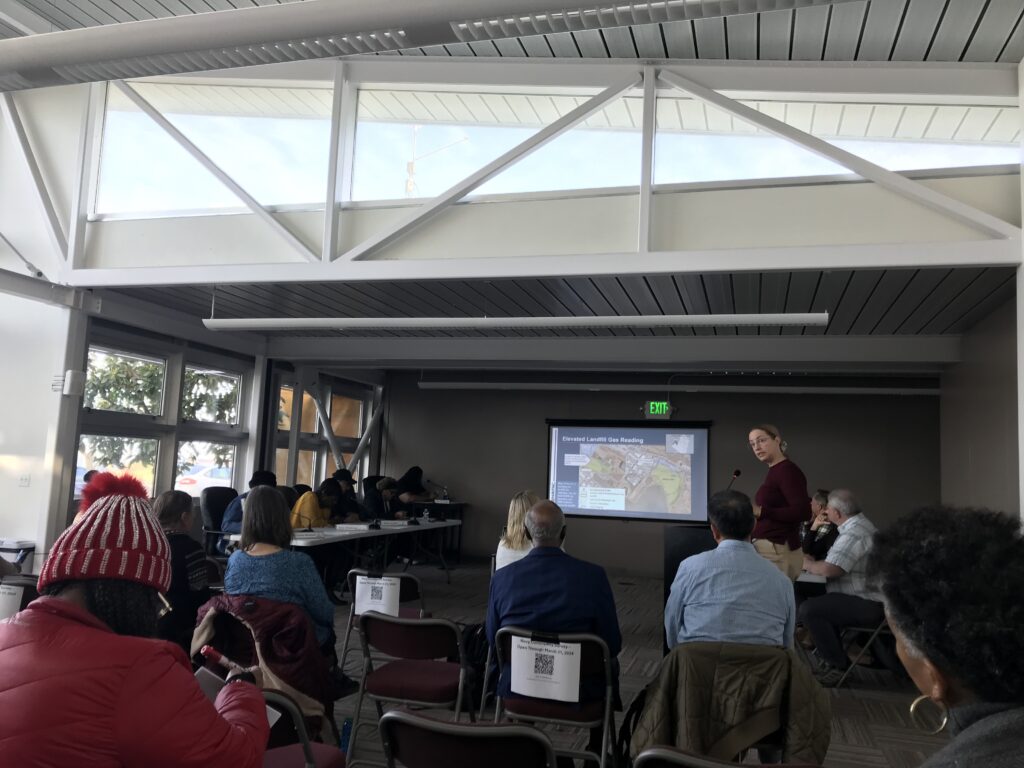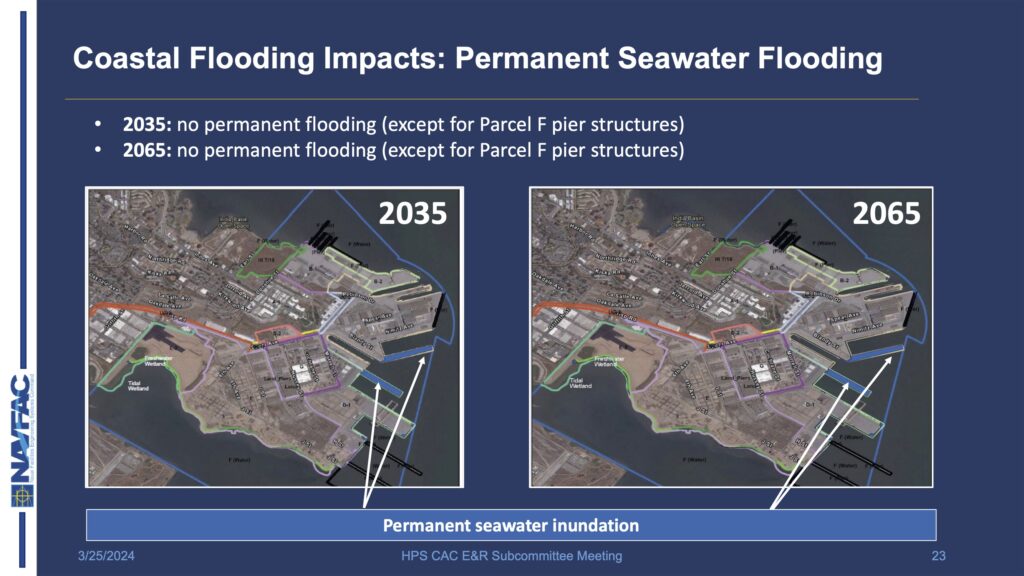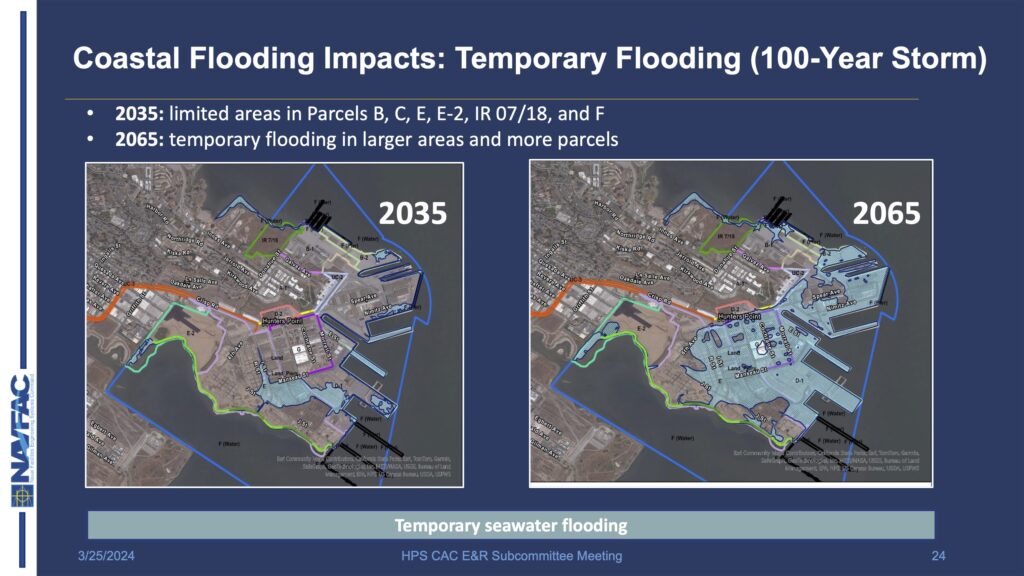The plan to clean-up and reuse the Hunters Point Shipyard has been contentious from the moment the 900-acre base closed in 1974. And after a KQED analysis of the Navy’s 5-year review of the clean-up revealed that contaminated groundwater could emerge on the site as early as 2035, contentions were on display at the HPS Citizens Advisory Committee Monday. March 25, in the Bayview.
Business-minded moderates in the community welcomed the employment and housing the repurposing could bring; community activists warned of adding more pollution to an already sickness-burdened community; and the Navy stayed the course that they, with EPA and other agency guidance, could deliver housing-starved San Francisco usable land—not a toxic mess mired in lawsuits for years to come.
The Navy’s hour-long PowerPoint presentation (PDF) began with Michael Pound, BRAC Environmental Coordinator, introducing Brooks Pauly, Lead Remedial Project Manager (Non-Radiological), who addressed elevated methane gas reading levels in Parcel E-2, an issue that Pound would later admit the Navy would most likely have to address “in perpetuity.”

There’s no question that Parcel E-2, which includes a toxic landfill that erupted into a toxic fire in 2000, is a problem. The 2022 Civil Grand Jury Report warned that contaminants all over the Shipyard could become mobile with groundwater rise and movement, so the landfill is not just a source of toxicity but a deep source of doubt about the clean-up.
“We are going to continue to monitor all the active monitoring wells,” Pauly said about Parcel E-2. “We’ll continue to update the public and other stakeholders at meetings like this as the work progresses, putting in the final remedy at the landfill.”
The promise to hire local workers for the demolition of Building 123 (as well as the Parcel G Building demolition) exposed a reoccurring tension for activists in the area, namely that the mostly poor, mostly African American community are forced to choose between good jobs or good health in San Francisco’s most industrialized area.
“The (air) monitoring program for the demolition phase will include three locations around the building,” Pauly said. “We’ll be looking for contaminants like asbestos, basically the kinds of things that could be put into the air from a demolition.”
Understanding the dense slide show required careful attention to terminology. As far as climate change risks, permanent seawater flooding projections in 2035 and 2065 were minimal, but temporary seawater flooding was more widespread. And when analyzing groundwater as opposed to seawater rise, the Navy warned that “rising groundwater may submerge underground utilities.”


Once the PowerPoint was finished, the community got their chance: a Q/A session restricted by three-minutes per person for those who had signed up.
Dr. Ahimsa Sumchai, who was on the Hunters Point Restoration Advisory board in 2000 during the E-2 toxic fire, challenged the methane readings and the Navy’s sea-level rise predictions.
“The California comptroller’s office identifies sea level rise as being as high as six feet. And the Civil Grand Jury also identified sea level rise reaching as high as six feet.”
Aside from the science, Sumchai was one of many speakers who talked about the Shipyard in a way the Navy presentation did not. They talked about the Shipyard as part of their home.
“I’m extremely concerned and disappointed how you quickly spoke about the exposure of methane,” Kamillah Ealom, Bayview Hunters Point Community Organizer/Program Coordinator for Greenaction, said. “I live less than four city blocks from Parcel E in Alice Griffith.”
La Shon Walker of Five Point walked the line between those worried about toxicity and those who hoped the project could somehow deliver dependable work and safe homes. Knowing PowerPoint slides don’t rebuild trust, Walker spoke less about substance and more about style.
“My neighbors are talking about rebuilding trust,” Walker said. “The information that you present is complicated information. But you have to speak about it with the community as if you respect who they are.”
“You seem afraid. And that contributes to the mistrust of the information you provide.”
In its defense, the Navy asked for more of the community to fill out questionnaires and to attend the community meetings more regularly. A public-review of the HPNS Draft Five-Year Review was extended until May 7, and the Navy will hold a Climate Resilience Workshop on April 22 and another CAC Subcommittee meeting on May 20.
No one denies that the combination of climate change and the nearly unknowable amount of toxins deposited over generations within the Shipyard creates a challenging clean-up. But for a community like Hunters Point, dumped on for generations, too many “I don’t know’s” from those in charge start to sound like “I don’t care.”
Strong words from the CAC Chair, Dr. Veronica Hunnicutt, acted as both a reassurance and a warning to all parties in the room.
“The CAC will not allow anything nefarious to happen to this community.”





